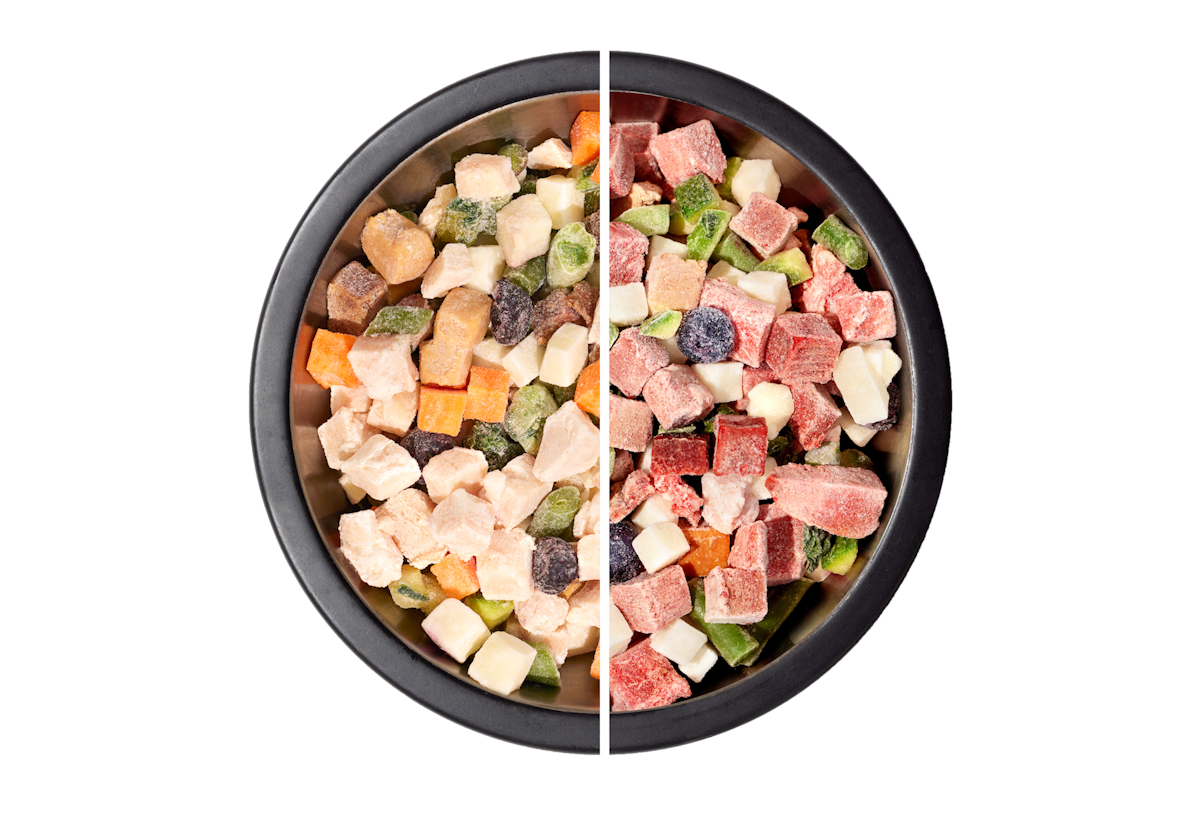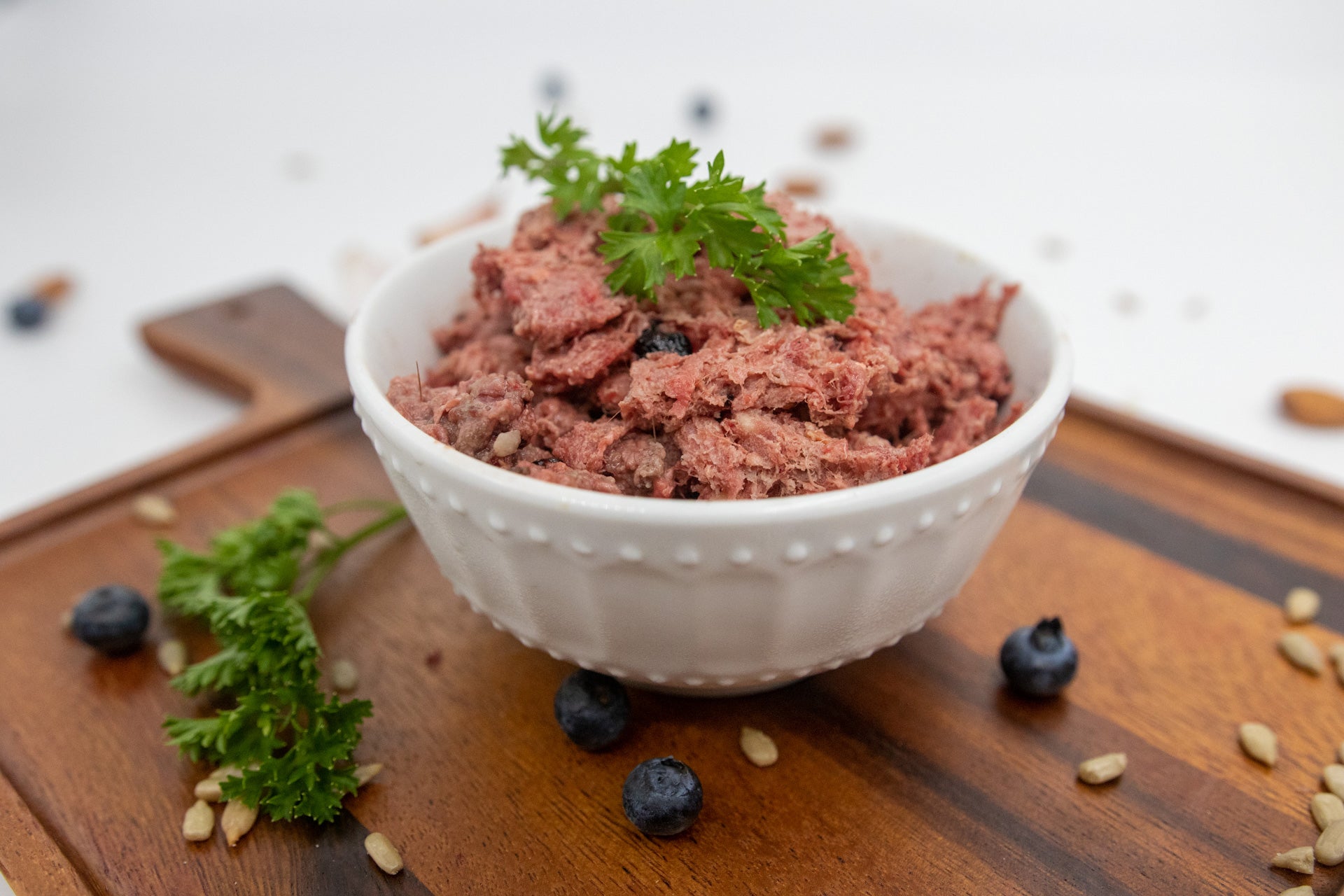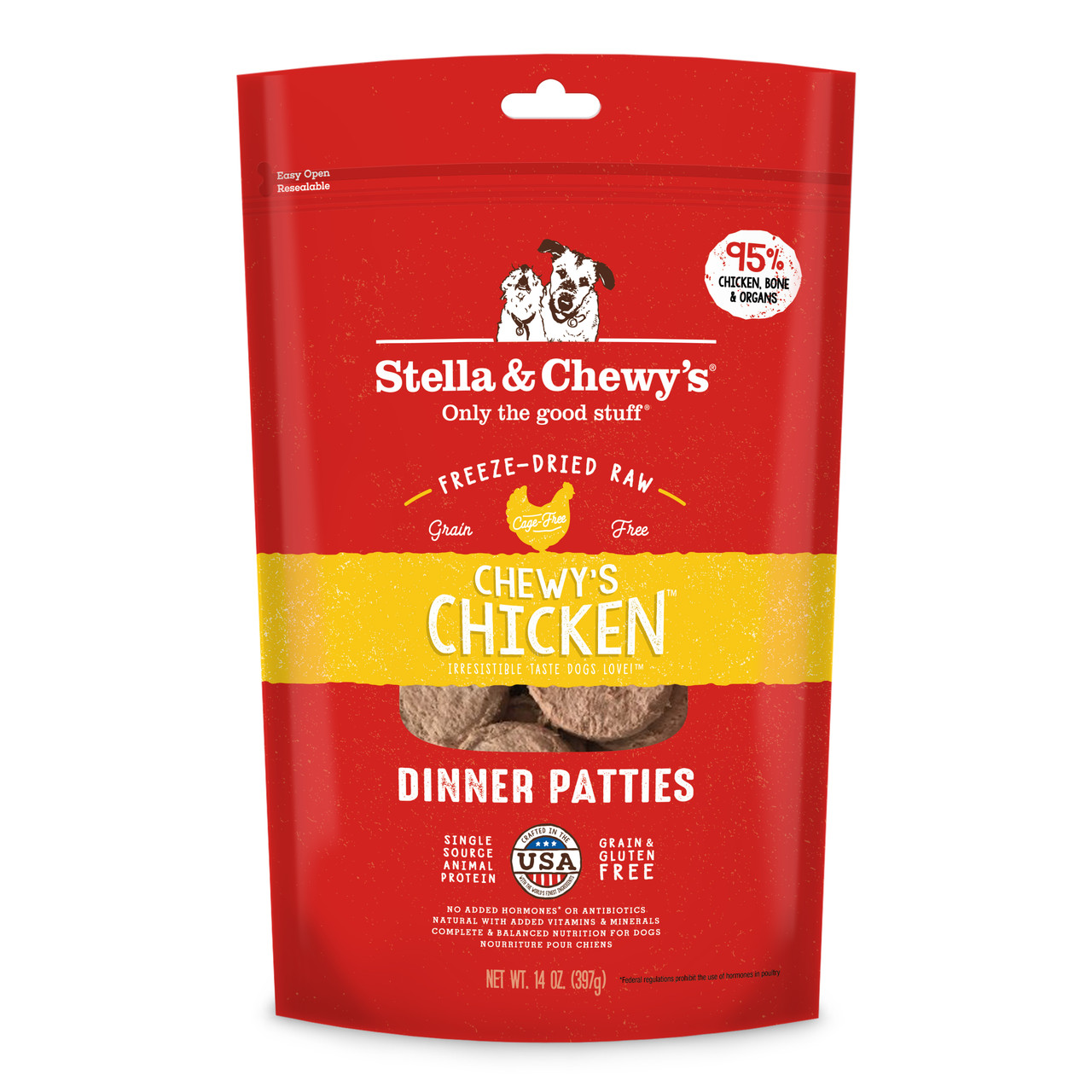7 Best Raw Dog Food Formulas of 2025
Updated on January 15, 2025

As more people seek out the absolute best foods for their pets, alternative dog foods — including raw diets, homemade food, and even freeze-dried and dehydrated foods — have become increasingly popular in recent years. Raw dog food in particular has been a major topic of discussion in the dog community. In fact, a recent study found that 33 percent of dog and cat owners would be interested in feeding their pet a raw diet, in large part thanks to the freshness of the food and the nutritional benefits it provides.
But what is raw dog food, exactly? And how does it benefit your pet? Here’s everything you need to know about a raw dog food diet and how to decide if it’s right for you and your furry best friend.
Our Raw Dog Food Picks
All featured products are chosen at the discretion of the Vetstreet editorial team and do not reflect a direct endorsement by the author. However, Vetstreet may make a small affiliate commission if you click through and make a purchase.
- Best Raw Dog Food Subscription: Maev
- Best Overall Raw Dog Food: We Feed Raw
- Best Organic Raw Dog Food: Darwin’s
- Best Freeze-Dried Raw Dog Food: Open Farm Freeze-Dried Raw Food Patties
- Best Raw Dog Food for Puppies: Instinct Frozen Raw Bites For Puppies
- Best Bulk Raw Dog Food: BJ’s Raw
- Best Raw Dog Food Patties: Stella & Chewy’s Raw Dinner Patties
7 Top Picks for Best Raw Dog Food
Best Raw Dog Food Subscription
Our pick: Maev

You can save yourself a trip to the pet store each month with Maev, a raw dog food subscription service. Featuring raw options for both adult dogs and puppies, the brand offers a flexible subscription plan, allowing you to choose your own quantity and delivery frequency. The food is formulated by veterinary nutritionists to meet AAFCO guidelines and made with 100 percent USDA-certified lean protein and whole vegetables that you can see. Maev currently offers beef and chicken recipes, but there are a variety of supplement mixtures that you can add to your dog’s food, including options for weight management, anxiety, or skin and coat health.
Unlike many other raw foods, Maev is designed to be served frozen, which some dogs might not like. Additionally, the brand doesn’t use any type of processing to eliminate bacterial pathogens in its foods.
Pros
- Flexible subscription plan via brand site (also available for individual purchase on Amazon)
- Formulas for adult dogs and puppies
- Meets AAFCO guidelines
- Formulated by veterinary nutritionists
- Different supplement mixtures available, depending on your dog’s needs
Cons
- Only beef or chicken formulas available
- Designed to be served frozen
- Food doesn’t undergo any processing to eliminate pathogens
Best Overall Raw Dog Food
Our pick: We Feed Raw

Get 25% off with code VS25
If you’re looking for raw option for your dog, one of your best bets is We Feed Raw. This brand does everything right in terms of nutrition and food safety. Their formulas are created by a Ph.D. animal nutritionist and meet AAFCO guidelines for all life stages. The food is also processed at a USDA-certified facility and undergoes cold-pressure processing to neutralize harmful bacteria in the meat.
We Feed Raw currently offers six different recipes, and you can either sign up for a subscription — where pre-portioned meals are delivered to your door on a recurring basis — or buy in bulk. They also ship for free within the 48 contiguous states and allow you to adjust the quantity and frequency of your deliveries as needed. You can cancel or pause your subscription at any time.
Pros
- Six proteins to choose from (beef, chicken, turkey, duck, lamb, and venison)
- Meets AAFCO guidelines for all life stages
- Formulated by a Ph.D. animal nutritionist
- Produced at a USDA-certified facility
- Available pre-portioned or in bulk
- Food undergoes processing to destroy harmful bacteria
- Free shipping within the U.S.
Cons
- Bulk patties can take up to 24 hours to thaw
- There’s a 30-pound minimum for bulk orders
Best Organic Raw Dog Food
Our pick: Darwin’s

Darwin’s offers a few different lines of raw foods, and its Natural Selections recipes are made using free-range meats and organic vegetables for meals that are free from steroids, antibiotics, and hormones. (Alternatively, the brand’s Biologics recipes are made using conventional ingredients, and the Intelligent Design recipes are prescription-only options for dogs with specific medical conditions.)
The Natural Selections line includes turkey, duck, chicken, beef, and lamb recipes, all of which meet AAFCO guidelines for complete and balanced nutrition. Plus, if you’re not sure which is best for your pet, the brand even offers free consultations. Darwin’s uses a subscription model, shipping frozen food to your home on a regular basis. They even have an introductory offer that allows you to purchase 10 pounds of food for just $15.
Pros
- Organic or standard formulas available
- Meets AAFCO guidelines
- Special formulas available for dogs with medical conditions
- Introductory discount on your first order
- Free consultations available
- Free shipping on orders over 20 pounds
Cons
- Unclear if food undergoes processing to kill pathogens
Best Freeze-Dried Raw Dog Food
Our pick: Open Farm Freeze-Dried Raw Dog Food Patties

20% off first auto-ship order with code VETSTREET
If you’re interested in raw dog food but don’t want to fill your freezer with pounds of meat, these freeze-dried raw dog food patties feature a shelf-stable formula that’s much more convenient. This option comes in four protein varieties, and the formula is designed to be rehydrated with water or bone broth before serving.
The recipes meet AAFCO guidelines for all life stages, including large-breed puppies. They’re made with meat free from antibiotics, steroids, and hormones, as well as non-GMO fruits and veggies. Plus, all of the ingredients are from certified family farms.
Pros
- Four humanely raised/wild caught protein options available: beef, chicken, turkey, and surf & turf
- Meets AAFCO guidelines for all life stages
- Gently freeze-dried raw formula
- Designed to be rehydrated with water or bone broth before serving
- Non-GMO fruits and vegetables
- Ingredients are 100% traceable
Cons
- Some customers said that the preparation instructions lacked detail
Best Raw Dog Food for Puppies
Our pick: Instinct Frozen Raw Bites For Puppies

Instinct offers a wide range of raw food for dogs, including frozen patties and bite-sized pieces in a variety of proteins. This brand also has a special formula designed for puppies — ideal for starting a young dog on a raw diet. Their cage-free chicken recipe meets AAFCO nutritional guidelines for small- and medium-breed puppies, though it’s not suitable for large-breed puppies. The formula includes raw ingredients that are frozen to preserve nutritional integrity and cold-pressured for safety (just thaw it 5 to 15 minutes before serving), and it’s free from grain, corn, wheat, soy, and artificial colors and preservatives. The bite-sized pieces are also easy for puppies to chew!
Pros
- Separate formulas for adult dogs and puppies
- Small bites are easy for puppies to chew
- Meets AAFCO nutritional guidelines
- Food undergoes processing to destroy harmful bacteria
- Lower price point than some others on the list
Cons
- Not suitable for large-breed puppies
- Only one flavor available for puppies (any dog that is expected to be 70 pounds or more as an adult)
Best Bulk Raw Dog Food
Our pick: BJ’s Raw

If you want to stock your freezer with raw food, BJ’s Raw offers 5-gallon bulk containers that include a whopping 38 pounds of food. The Pennsylvania-based brand uses locally sourced protein in all of its raw mixtures, and the formulas meet AAFCO guidelines for all life stages. Additionally, BJ’s has a wide range of proteins to choose from, including unconventional options like rabbit, goat, sheep, tripe, and more. The brand also sells supplemental organ meats and whole prey options, such as turkey necks, chicken feet, and more. Just keep in mind that they don’t use any processing methods to eliminate bacterial pathogens, so you’ll need to be especially careful when handling the food.
Pros
- Locally sourced protein
- Meets AAFCO guidelines
- Available via subscription or bulk containers
- Wide range of protein options
- Good price point
Cons
- Shipping can be expensive, depending on your location
- Food doesn’t undergo any processing to eliminate pathogens
Best Raw Dog Food Patties
Our pick: Stella & Chewy’s Raw Dinner Patties

It’s often easier to portion out raw food when it comes in patty form, which is why Stella & Chewy’s Raw Dinner Patties are so popular. These raw meals are available in either frozen or freeze-dried formulas, and the brand offers a wide range of proteins, including venison, rabbit, and turkey. The patties are made with meat, organs, bone, and organic fruits and vegetables, and the food is processed to eliminate harmful bacteria.
However, the raw food patties are on the smaller side. If you have a dog that’s 50 pounds or more, you may need to feed them upward of 10 patties per day, meaning you’ll go through each package quite quickly.
Pros
- Several protein options available
- Choose from frozen or shelf-stable freeze-dried patties
- Meets AAFCO guidelines for all life stages
- Organic fruits and vegetables
- Food undergoes HPP to destroy harmful bacteria
- Brand safety tests batches before packaging
Cons
- Larger dogs may need 10+ patties per day
- Freeze-dried patties can get crushed in the bag
What is Raw Dog Food?
As its name suggests, raw dog food is primarily made up of raw — or uncooked — meat. “Raw dog food may utilize the muscle portions of the meat, like we typically eat, or it may include some organs and ground bone, or a combination,” explains Dr. Libby Czapor, DVM, a Chicago-based veterinarian. “Companies often include varieties of fruits and vegetables in their raw dog food as well.” Because the food is uncooked, it needs to be stored and handled much more carefully than traditional dry dog food.
Raw food for dogs is often available in frozen packages that you thaw before serving, but some brands do offer freeze-dried or dehydrated raw dog food that’s a bit easier to store and handle. These foods come in several forms: some brands simply provide a large chunk of meat that you can portion yourself, while others offer pre-portioned patties or bite-size pieces for your pup.
Pros and Cons of Raw Dog Food

Let’s go over a few of the pros and cons of feeding your pup a raw diet.
Pros
Advocates for raw dog food say that this type of diet can lead to improved skin and coat health, increased energy, and smaller stools. However, it’s important to note that most of this evidence is only anecdotal.
“The research surrounding raw food diets is still limited, and a lot of the information that we have is based on self-reported epidemiological studies,” says Dr. Czapor. “Some companies provide reports of research they have done as well, but it is always important to consider any form of bias within self-performed research studies.”
Many pet parents that feed raw dog food report improved coat and skin health and smaller, firmer stools. Dogs may also have more energy and better breath.
Cons
On the other side of the coin, the main downside of raw dog food is that it needs to be stored and handled very carefully. “The largest safety concern in feeding raw diets is the presence of microbial pathogens that may be on/in the meat,” Dr. Czapor explains. “These pathogens not only put the dog at risk for illness such as gastrointestinal upset, but are also concerning for zoonotic potential, or the ability to cause illness in humans.”
In a study by the FDA Center for Veterinary Medicine, scientists analyzed 196 raw pet food samples and found that 15 were positive for Salmonella and 32 were positive for L. monocytogenes. Both of these are pathogens that are dangerous to humans.
To help eliminate these pathogens from raw food, many manufacturers now use high-pressure processing (HPP), a food preservation method that utilizes cold water and high pressure to kill bacteria. However, because of the concerns surrounding fresh and frozen raw food, some pet parents may prefer freeze-dried or dehydrated raw dog food, which offer similar nutritional benefits with lower risk of contamination.
Raw Dog Food: What to Look For
When shopping for raw food, it’s important to keep your dog’s nutritional needs in mind. “As with any type of dog food, a brand that utilizes food trials is important to ensure your pet is getting a nutritionally balanced meal,” says Dr. Czapor. “Unbalanced raw food diets are much more likely when the diet is homemade.”
Just like dry dog food, raw food should be formulated to meet AAFCO guidelines and have a nutrition label that says it’s a complete and balanced source of nutrition for your dog’s life stage, whether adult, puppy, lactating mother, etc. You may also want to select a brand with foods formulated by a Ph.D. animal nutritionist.
To minimize the risk of harmful pathogens, it’s important to research how the manufacturer processes its food. This might include high-pressure processing, freeze-drying, or another method. Other factors to consider as you compare foods include the ingredients used and where the meats are sourced.
How We Selected Our Picks
Here are the main factors we considered while compiling our list.
Standards/processing. Because of the potential risk of pathogens in raw dog food, we paid close attention to the certifications and processing procedure for each selection. We called out when a brand has protocol in place to ensure the safety of their food, as well as when they don’t.
Ease of use/preparation. Raw dog food can get a little tricky to serve, especially if it’s frozen. That’s why we highlighted convenience factors for each, like how easy it is to prep or store.
Ratings/reviews. We checked out what other pet parents are saying about each option and only chose those with solid overall customer ratings.
Price. Because raw dog food tends to be on the pricier side in general, most of our selections are more expensive than your standard kibble. We still tried to include a range of options to fit a variety of budgets.

Raw Dog Food FAQ
We understand that the idea of raw food can prompt a bunch of questions from pet parents, so we’ve answered some of the most common ones below.
Can dogs eat raw food? Is it safe?
Yes, it is generally considered safe for healthy dogs to eat raw meat. Their digestive systems have stronger stomach acids than those of humans, allowing them to break down protein and bones quickly, as well as kill off most harmful bacteria. However, some pathogens that can be found in raw meat, such as Salmonella, may cause gastrointestinal upset. It’s always best to check with your veterinarian before switching your dog to a raw food diet.
What exactly goes in raw food for dogs?
Raw food diets are uncooked and generally consist of raw meat, organ meat, bones, vegetables, fruits, and supplements. Each formula is different, so be sure to read the ingredient list.
Can raw food help a dog with allergies?
A raw food diet can help dogs with allergies in many cases, especially if the dog’s previous offending ingredient(s) are no longer being fed.
Is raw food good for dogs?
There haven’t been many scientific studies to prove the benefits of a raw diet for dogs, but there is quite a bit of anecdotal evidence from pet owners. Many people who feed a raw diet say that it helps improve their dog’s skin and coat, energy levels, and more.
How much raw food should you feed a dog?
As a general rule of thumb, you’ll want to feed your dog between 2 percent and 4 percent of their body weight in raw food each day, split between two meals. So for a 50-pound dog, you’ll want to feed them 1 to 2 pounds of raw food daily.
What raw foods can dogs eat?
Dogs can eat a wide range of raw foods, including muscle meat, ground or whole bones, organ meat, raw eggs, raw vegetables and fruit, and some dairy.
Raw Dog Food: Tips and Advice

If you have questions about whether a raw diet is appropriate for your dog, it’s a good idea to talk with your veterinarian, who will be able to weigh in on your dog’s specific individual needs.
For example, dogs with certain medical conditions are often not good candidates for a raw diet. “Any dogs with immune-compromising diseases or on immune-compromising medications should avoid raw diets,” recommends Dr. Czapor. “Importantly, each pet is an individual and it is imperative to work with your veterinarian to find out what’s best for your furry friend.”
When feeding your dog raw food, proper storage, handling, and preparation are essential to keeping both you and your dog healthy. Raw food should be kept frozen until you plan to use it and kept away from other food in your refrigerator while it’s thawing, according to the CDC. After serving the food to your dog, wash your hands thoroughly with soap and water, then disinfect any surfaces that the raw food touches. Finally, you’ll want to avoid letting your dog lick your face after they’ve eaten raw food.





